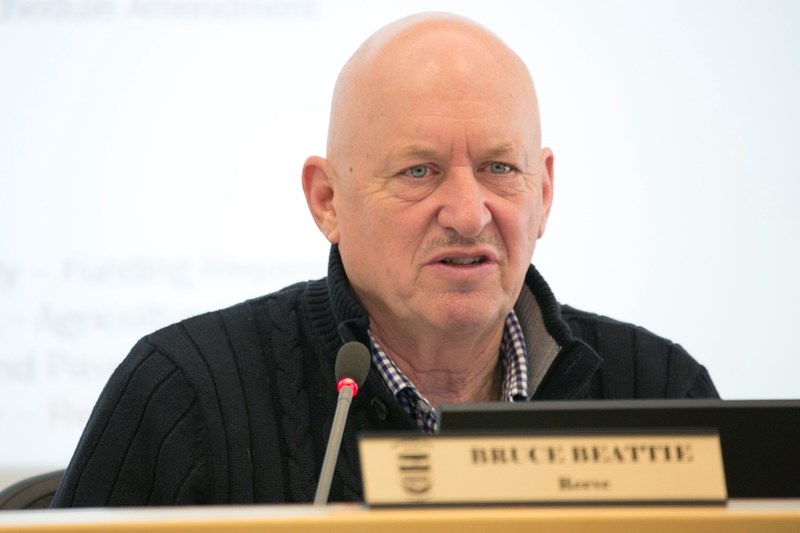A newly-released plan makes 11 recommendations aimed at improving and protecting the Red Deer River and its tributaries.
The “Blueprint: An integrated watershed management plan for the Red Deer River watershed” presents goals, targets and recommendations regarding groundwater and surface water.
The plan was prepared and released by the Red Deer River Watershed Alliance (RDRWA), which includes representatives from municipalities such as Mountain View and Red Deer counties.
Bruce Beattie, Mountian View County reeve and the county's representative on RDRWA, calls the report a good move forward.
“I think it is a very well-written, wide-ranging report,” Beattie told the Gazette. “There has been an awful lot of work that went into the report; good scientific work.
“It's a good first step in developing a good, strong strategy to ensure the quality and availability of water in the watershed.”
RDRWA executive director Jeff Hanger said, “The plan serves as advice to all watershed stakeholders to guide future decision-making and activities in their respective areas of responsibility and interest. It is really about bringing together various players to identify gaps and work on shared solutions. As a living document, the plan will be updated as the process continues on the subsequent phases that address land use, riparian area, wetlands, biodiversity and water quality in the watershed.”
A watershed is an area of land that drains water into bodies of water such as rivers, streams, lakes and wetland.
The 50,000-square-kilometre Red Deer River Watershed includes the Red Deer River, Bearberry Creek, the James River and Gleniffer Lake.
The 11 recommendations in the plan are as follows:
• Improve the understanding and strengthen the commitment of watershed users to protect water quality.
“Improming water literacy equips our communities with the knowledge and tools required to understand the complexity of watershed issues and to effect change,” he said. “Water literacy requires understanding how our activities on the landscape influence water quality.”
• Establish a robust monitoring program for surface water quality.
“By collecting data and information on the condition of water quality, people can understand trends and changes over time,” he said.
“There is a need to expand surface water quality monitoring efforts across the watershed to fill existing knowledge gaps and inform decision-making that affects land use.”
• Develop and implement a management-response framework for the Red Deer River and major tributaries.
“In order to maintain and improve surface water quality, it is necessary to have a clear framework for how we can work together that is proactive, fair and science-based,” he said.
• Encourage and promote the implementation of beneficial management practices across municipalities, industry and agriculture.
“There are many proactive measures that can be taken to maintain or improve water quality, and that go beyond current legislation,” he said.
• Research, curate and share information on emerging issues that impact water quality.
“Human activities and watershed conditions are changing, and we need to make sure that we are managing for this change,” he said.
• Identify and address risks to source waters, including water used as a source of drinking water.
“Source water protection is a strategy by which municipalities and water providers can indentify risks and implement actions to reduce risks to water used as a source of drinking water,” he said.
• Fill information gaps to improve lake monitoring and inform the development of lake watershed management plans.
“To protect our lakes, there is a need for increased water quality monitoring, enhanced lake watershed research, and the development of lake watershed management plans with all stakeholders,” he said.
• Establish a robust monitoring program for groundwater quality.
• Establish an integrated monitoring, evaluation, management and reporting framework for groundwater quality.
“We need to know more about the quality of our groundwater resources. A robust groundwater monitoring network is key to understanding local and regional groundwater quality and cumulative effects,” he said.
• Expand efforts to map and characterize groundwater resources across the watershed.
“In order to maintain and improve groundwater quality, it is necessary to have a clear framework for how we can work together that is proactive, fair and science-based,” he said.
• Incorporate the sustainable management of groundwater quality, including the protection of recharge areas, into land-use planning and resource management.
“Groundwater is often overlooked and undervalued in decision-making. Any important land use decision should consider the potential impact on the sustainable management of groundwater quality,” he said.
Reeve Beattie says he hopes the 11 recommendations will be implemented.
“In combination with the Red Deer River municipal users group, between our report on the quality of the watershed and some of the recommendations in terms of conservation, I think they make an excellent basis for building the future for a healthy watershed,” said Beattie.
"It's a good first step in developing a good strong strategy to ensure the quality and availability of water in the watershed."Bruce Beattie,Mountain View County Reeve



